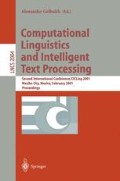Abstract
The paper expounds the general conceptions of the Meaning- Text theory about what a natural language is and how it must be de- scribed. In a second part, a formalization of these conceptions - the transductive grammars - is proposed and compared with generative ap- proaches.
I want to thank Kim Gerdes, Alain Polguère and Pascal Amsili for many valuable comments and corrections. I want also to thank Alexander Gelbukh for his sugges- tions about the topic of this paper.
Access this chapter
Tax calculation will be finalised at checkout
Purchases are for personal use only
Preview
Unable to display preview. Download preview PDF.
References
Aho Alfred & Ullman Jeffrey, 1972, The Theory of Parsing, Translation and Compiling, Vol. I: Parsing, London: Prentice-Hall.
Arnola Harri, 1998, “On parsing binary dependency structures deterministically in linear time”, in Kahane & Polguère (eds), Workshop on dependency-based grammars, COLING-ACL’98, Montreal, 68–77.
Blanche Philippe, 1998, “Parsing ambiguous structures using controlled disjunctions and unary quasi-trees”, Proc. COLING-ACL ’98, Montreal, 124–130.
Boyer Michel & Lapalme Guy, 1985, “Generating paraphrases from Meaning-Text semantic networks”, Comput. Intell., 1, 103–117.
Brody Michael, 1997, Lexico-Logical Form: A Radically Minimalist Theory, Cambridge: MIT Press.
Chomsky Noam, 1957, Syntactic Structure, Cambridge: MIT Press.
Courtin Jacques & Genthial Damien, 1998, “Parsing with Dependency Relations and Robust Parsing”, in Kahane & Polguère (eds), Workshop on dependency-based grammars, COLING-ACL’98, Montreal, 95–101.
Dikovsky Alexander & Modina Larissa, 2000, “Dependencies on the other side of the Curtain”, in S. Kahane (ed.), Grammaires de dépendance, T.A.L., 41:1.
Gaifman Haïm, 1965, “Dependency systems and phrase-structure systems”, Information and Control8, 304–337; Rand Corporation Techn. Report RM-2315, 1961.
Gladkij Aleksej & Mel’čuk Igor, 1975, “Tree grammars: A Formalism for Syntactic Transformations in Natural Language”, Linguistics, 150, 47–82.
Iordanskaja Lidija, 1963, “O nekotoryx svojstvax pravil’noj sintaksičeskoj struktury (na materiale russkogo jazyka)” [On some properties of the correct syntactic structure (on the basis of Russian)], Voprosy jazykoznanija, 4, 102–12.
Iordanskaja Lidija & Polguère Alain, 1988, “Semantic processing for text generation”, in Proc. First International Computer Science Conf.-88, Hong Kong, 310–18.
Jackendoff Ray S., 1977, X’ Syntax: A Study of Phrase Structure, Linguistic Inquiry Monograph, MIT Press.
Kahane Sylvain, 1997, “Bubble trees and syntactic representations”, in Becker & Krieger (eds), Proc. 5th Meeting of the Mathematics of Language (MOL5), Saarbrücken: DFKI.
Kahane Sylvain, 2001, “A fully lexicalized grammar for French based on the Meaning-Text theory”, this issue.
Kahane Sylvain & Mel’čuk Igor, 1999, “Synthèse des phrases à extraction en français contemporain (Du graphe sémantique à l’arbre de dépendance)”, T.A.L., 40:2, 25–85.
Lecerf Yves, 1961, “Une représentation algébrique de la structure des phrases dans diverses langues naturelles”, C. R. Acad. Sc. Paris, 252, 232–234.
Kornaï Andreás & Tuza Zsolt, 1992, “Narrowness, pathwidth, and their application in natural language processing”, Disc. Appl. Math, 36, 87–92.
Mel’čuk Igor, 1967, “Ordre des mots en synthèse automatique des textes russes”, T.A. Informations, 8:2, 65–84.
Mel’čuk Igor, 1988, Dependency Syntax: Theory and Practice, Albany, NY: State Univ. of New York Press.
Mel’čuk Igor, 1997, Vers une Linguistique Sens-Texte, Leçon inaugurale au Collège de France, Paris: Collège de France.
Mel’çuk Igor, 1993-2000, Cours de morphologie générale, Vol. 1, 2, 3, 4 & 5, Montreal: Presses de l’Univ. Montreal / Paris: CNRS.
Mel’çuk Igor & Pertsov Nikolaj, 1987, Surface Syntax of English. A Formal Model within the Meaning-Text Framework, Amsterdam: Benjamins.
Mel’çuk Igor et al., 1984, 1988, 1992, 1999, Dictionnnaire explicatif et combinatoire du français contemporain, Vol. 1, 2, 3, 4,Montreal: Presses de l’Univ. Montreal.
Milićević Jasmina, 2001, “A short guide to the Meaning-Text linguistic theory”, in Alexander Gelbukh (ed.), Computational Linguistics and Intelligent Text Processing, Colección en Ciencias de Computación, Fondo de Cultura Económica-IPN-UNAM, Mexico.
Nasr Alexis, 1995, “A formalism and a parser for lexicalised dependency grammars”, 4th Int. Workshop on Parsing Technologies, State Univ. of NY Press.
Polguère Alain, 1997, “Meaning-Text Semantic Networks as a Formal Language”, in L. Wanner (ed.), Recent Trends in Meaning-Text Theory, Amsterdam/Philadelphia: Benjamins.
Pollard Carl & Sag Ivan A., 1994, Head-Driven Phrase Structure Grammar, CSLI series, Chicago: Univ. of Chicago Press.
Žolkovskij Aleksandr & Mel’çuk Igor, 1965, “O vozmožnom metode i instrumentax semantičeskogo sinteza” [On a possible method an instruments for semantic synthesis (of texts)], Naučno-texničeskaja informacija [Scientific and Technological Information], 6, 23–28.
Žolkovskij Aleksandr & Mel’čuk Igor, 1967, “O semantičeskom sintez” [On semantic synthesis (of texts)], Problemy kybernetiki [Problems of Cybernetics], 19, 177–238. [Fr. transl.: 1970, T.A. Information, 2, 1-85.]
Author information
Authors and Affiliations
Editor information
Editors and Affiliations
Rights and permissions
Copyright information
© 2001 Springer-Verlag Berlin Heidelberg
About this paper
Cite this paper
Kahane, S. (2001). What Is a Natural Language and How to Describe It? Meaning-Text Approaches in Contrast with Generative Approaches. In: Gelbukh, A. (eds) Computational Linguistics and Intelligent Text Processing. CICLing 2001. Lecture Notes in Computer Science, vol 2004. Springer, Berlin, Heidelberg. https://doi.org/10.1007/3-540-44686-9_1
Download citation
DOI: https://doi.org/10.1007/3-540-44686-9_1
Published:
Publisher Name: Springer, Berlin, Heidelberg
Print ISBN: 978-3-540-41687-6
Online ISBN: 978-3-540-44686-6
eBook Packages: Springer Book Archive

